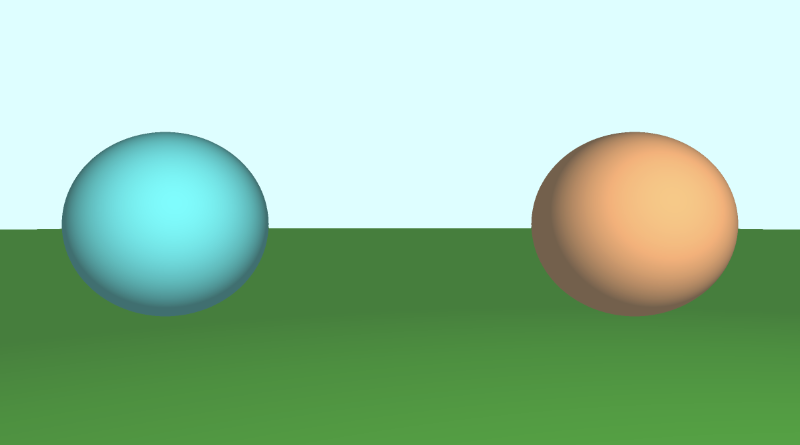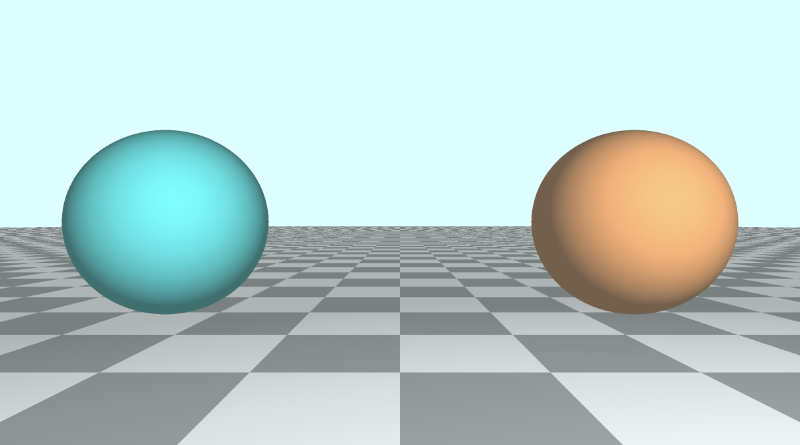7.3 添加单独颜色
7.3.1 方法一
Shadertoy 中的人们使用多种技术向 3D 形状添加颜色。一种方法是修改 SDF 以返回到形状的距离和颜色。因此,我们必须修改代码中的多个位置以返回 vec4 数据类型而不是浮点数。vec4 变量的第一个值将保存我们通常从 SDF 返回的“有符号距离”值,而最后三个值将保存我们的颜色值。
完成的代码应如下所示:
const int MAX_MARCHING_STEPS = 255;
const float MIN_DIST = 0.0;
const float MAX_DIST = 100.0;
const float PRECISION = 0.001;
vec4 sdSphere(vec3 p, float r, vec3 offset, vec3 col )
{
float d = length(p - offset) - r;
return vec4(d, col);
}
vec4 sdFloor(vec3 p, vec3 col) {
float d = p.y + 1.;
return vec4(d, col);
}
vec4 minWithColor(vec4 obj1, vec4 obj2) {
if (obj2.x < obj1.x) return obj2; // The x component of the object holds the "signed distance" value
return obj1;
}
vec4 sdScene(vec3 p) {
vec4 sphereLeft = sdSphere(p, 1., vec3(-2.5, 0, -2), vec3(0, .8, .8));
vec4 sphereRight = sdSphere(p, 1., vec3(2.5, 0, -2), vec3(1, 0.58, 0.29));
vec4 co = minWithColor(sphereLeft, sphereRight); // co = closest object containing "signed distance" and color
co = minWithColor(co, sdFloor(p, vec3(0, 1, 0)));
return co;
}
vec4 rayMarch(vec3 ro, vec3 rd, float start, float end) {
float depth = start;
vec4 co; // closest object
for (int i = 0; i < MAX_MARCHING_STEPS; i++) {
vec3 p = ro + depth * rd;
co = sdScene(p);
depth += co.x;
if (co.x < PRECISION || depth > end) break;
}
vec3 col = vec3(co.yzw);
return vec4(depth, col);
}
vec3 calcNormal(in vec3 p) {
vec2 e = vec2(1.0, -1.0) * 0.0005; // epsilon
return normalize(
e.xyy * sdScene(p + e.xyy).x +
e.yyx * sdScene(p + e.yyx).x +
e.yxy * sdScene(p + e.yxy).x +
e.xxx * sdScene(p + e.xxx).x);
}
void mainImage( out vec4 fragColor, in vec2 fragCoord )
{
vec2 uv = (fragCoord-.5*iResolution.xy)/iResolution.y;
vec3 backgroundColor = vec3(0.835, 1, 1);
vec3 col = vec3(0);
vec3 ro = vec3(0, 0, 3); // ray origin that represents camera position
vec3 rd = normalize(vec3(uv, -1)); // ray direction
vec4 co = rayMarch(ro, rd, MIN_DIST, MAX_DIST); // closest object
if (co.x > MAX_DIST) {
col = backgroundColor; // ray didn't hit anything
} else {
vec3 p = ro + rd * co.x; // point on sphere or floor we discovered from ray marching
vec3 normal = calcNormal(p);
vec3 lightPosition = vec3(2, 2, 7);
vec3 lightDirection = normalize(lightPosition - p);
// Calculate diffuse reflection by taking the dot product of
// the normal and the light direction.
float dif = clamp(dot(normal, lightDirection), 0.3, 1.);
// Multiply the diffuse reflection value by an orange color and add a bit
// of the background color to the sphere to blend it more with the background.
col = dif * co.yzw + backgroundColor * .2;
}
// Output to screen
fragColor = vec4(col, 1.0);
}

在我们的代码中,我们必须在多个位置进行调整以满足编译器的要求。我们更改的第一件事是修改 SDF 以返回 vec4 值而不是浮点数。
vec4 sdSphere(vec3 p, float r, vec3 offset, vec3 col )
{
float d = length(p - offset) - r;
return vec4(d, col);
}
vec4 sdFloor(vec3 p, vec3 col) {
float d = p.y + 1.;
return vec4(d, col);
}
这两个函数现在都接受 color 的新参数。但是,这破坏了我们在 sdScene 函数中使用的 min 函数,因此我们也必须对其进行修改并创建自己的 min 函数。
vec4 minWithColor(vec4 obj1, vec4 obj2) {
if (obj2.x < obj1.x) return obj2;
return obj1;
}
vec4 sdScene(vec3 p) {
vec4 sphereLeft = sdSphere(p, 1., vec3(-2.5, 0, -2), vec3(0, .8, .8));
vec4 sphereRight = sdSphere(p, 1., vec3(2.5, 0, -2), vec3(1, 0.58, 0.29));
vec4 co = minWithColor(sphereLeft, sphereRight); // co = closest object containing "signed distance" and color
co = minWithColor(co, sdFloor(p, vec3(0, 1, 0)));
return co;
}
minWithColor 函数执行与 min 函数相同的操作,不同之处在于它返回一个 vec4,该 vec4 同时包含“有符号距离”值和光线行进循环期间最近的对象的颜色。说到光线行进,我们也必须修改 rayMarch 函数以满足编译器的要求。
vec4 rayMarch(vec3 ro, vec3 rd, float start, float end) {
float depth = start;
vec4 co; // closest object
for (int i = 0; i < MAX_MARCHING_STEPS; i++) {
vec3 p = ro + depth * rd;
co = sdScene(p);
depth += co.x;
if (co.x < PRECISION || depth > end) break;
}
vec3 col = vec3(co.yzw);
return vec4(depth, col);
}
我们还必须修改 calcNormal 函数,以提取出我们从 sdScene 函数返回的对象的 x 分量:
vec3 calcNormal(in vec3 p) {
vec2 e = vec2(1.0, -1.0) * 0.0005; // epsilon
return normalize(
e.xyy * sdScene(p + e.xyy).x +
e.yyx * sdScene(p + e.yyx).x +
e.yxy * sdScene(p + e.yxy).x +
e.xxx * sdScene(p + e.xxx).x);
}
最后,我们修改了 mainImage 函数以也使用这些更改。
void mainImage( out vec4 fragColor, in vec2 fragCoord )
{
vec2 uv = (fragCoord-.5*iResolution.xy)/iResolution.y;
vec3 backgroundColor = vec3(0.835, 1, 1);
vec3 col = vec3(0);
vec3 ro = vec3(0, 0, 3); // ray origin that represents camera position
vec3 rd = normalize(vec3(uv, -1)); // ray direction
vec4 co = rayMarch(ro, rd, MIN_DIST, MAX_DIST); // closest object
if (co.x > MAX_DIST) {
col = backgroundColor; // ray didn't hit anything
} else {
vec3 p = ro + rd * co.x; // point on sphere or floor we discovered from ray marching
vec3 normal = calcNormal(p);
vec3 lightPosition = vec3(2, 2, 7);
vec3 lightDirection = normalize(lightPosition - p);
// Calculate diffuse reflection by taking the dot product of
// the normal and the light direction.
float dif = clamp(dot(normal, lightDirection), 0.3, 1.);
// Multiply the diffuse reflection value by an orange color and add a bit
// of the background color to the sphere to blend it more with the background.
col = dif * co.yzw + backgroundColor * .2;
}
// Output to screen
fragColor = vec4(col, 1.0);
}
我们使用 col.x 提取出 signed distance 值,并使用 col.yzw 获取颜色。
使用此方法可以将值存储在 vec4 中,就像它们是其他语言中的数组一样。GLSL 也允许您使用数组,但它们不如 JavaScript 等语言灵活。您必须知道数组中有多少个值,并且只能在数组中存储相同类型的值。
7.3.2 方法二
如果使用 vec4 来存储距离和颜色感觉像是一个脏的解决方案,那么另一种选择是使用结构体。结构是组织 GLSL 代码的好方法。结构体的定义类似于 C++ 语法。如果您不熟悉 C++,而更熟悉 JavaScript,则可以将结构体视为对象和类的组合。让我们看看我这是什么意思。
结构可以具有属性。让我们创建一个名为 Surface 的结构体。
struct Surface {
float signedDistance;
vec3 color;
};
您可以创建返回 Surface 结构体的函数,也可以创建结构体的新实例:
// This function's return value is of type "Surface"
Surface sdSphere(vec3 p, float r, vec3 offset, vec3 col)
{
float d = length(p - offset) - r;
return Surface(d, col); // We're initializing a new "Surface" struct here and then returning it
}
您可以使用点语法访问结构体的属性:
Surface minWithColor(Surface obj1, Surface obj2) {
if (obj2.sd < obj1.sd) return obj2; // The sd component of the struct holds the "signed distance" value
return obj1;
}
凭借我们对结构体的新知识,我们可以修改代码以使用结构体而不是使用 vec4。
const int MAX_MARCHING_STEPS = 255;
const float MIN_DIST = 0.0;
const float MAX_DIST = 100.0;
const float PRECISION = 0.001;
struct Surface {
float sd; // signed distance value
vec3 col; // color
};
Surface sdSphere(vec3 p, float r, vec3 offset, vec3 col)
{
float d = length(p - offset) - r;
return Surface(d, col);
}
Surface sdFloor(vec3 p, vec3 col) {
float d = p.y + 1.;
return Surface(d, col);
}
Surface minWithColor(Surface obj1, Surface obj2) {
if (obj2.sd < obj1.sd) return obj2; // The sd component of the struct holds the "signed distance" value
return obj1;
}
Surface sdScene(vec3 p) {
Surface sphereLeft = sdSphere(p, 1., vec3(-2.5, 0, -2), vec3(0, .8, .8));
Surface sphereRight = sdSphere(p, 1., vec3(2.5, 0, -2), vec3(1, 0.58, 0.29));
Surface co = minWithColor(sphereLeft, sphereRight); // co = closest object containing "signed distance" and color
co = minWithColor(co, sdFloor(p, vec3(0, 1, 0)));
return co;
}
Surface rayMarch(vec3 ro, vec3 rd, float start, float end) {
float depth = start;
Surface co; // closest object
for (int i = 0; i < MAX_MARCHING_STEPS; i++) {
vec3 p = ro + depth * rd;
co = sdScene(p);
depth += co.sd;
if (co.sd < PRECISION || depth > end) break;
}
co.sd = depth;
return co;
}
vec3 calcNormal(in vec3 p) {
vec2 e = vec2(1.0, -1.0) * 0.0005; // epsilon
return normalize(
e.xyy * sdScene(p + e.xyy).sd +
e.yyx * sdScene(p + e.yyx).sd +
e.yxy * sdScene(p + e.yxy).sd +
e.xxx * sdScene(p + e.xxx).sd);
}
void mainImage( out vec4 fragColor, in vec2 fragCoord )
{
vec2 uv = (fragCoord-.5*iResolution.xy)/iResolution.y;
vec3 backgroundColor = vec3(0.835, 1, 1);
vec3 col = vec3(0);
vec3 ro = vec3(0, 0, 3); // ray origin that represents camera position
vec3 rd = normalize(vec3(uv, -1)); // ray direction
Surface co = rayMarch(ro, rd, MIN_DIST, MAX_DIST); // closest object
if (co.sd > MAX_DIST) {
col = backgroundColor; // ray didn't hit anything
} else {
vec3 p = ro + rd * co.sd; // point on sphere or floor we discovered from ray marching
vec3 normal = calcNormal(p);
vec3 lightPosition = vec3(2, 2, 7);
vec3 lightDirection = normalize(lightPosition - p);
// Calculate diffuse reflection by taking the dot product of
// the normal and the light direction.
float dif = clamp(dot(normal, lightDirection), 0.3, 1.);
// Multiply the diffuse reflection value by an orange color and add a bit
// of the background color to the sphere to blend it more with the background.
col = dif * co.col + backgroundColor * .2;
}
// Output to screen
fragColor = vec4(col, 1.0);
}
此代码的行为应与我们之前使用 vec4 时的行为相同。在我看来,结构体更容易推理,看起来也更简洁。您也不必像在 vec4 向量中那样被限制在 4 个值中。选择您喜欢的任何方法。
如果你想制作一个花哨的瓷砖地板,你可以像这样调整地板的颜色。
Surface sdScene(vec3 p) {
Surface sphereLeft = sdSphere(p, 1., vec3(-2.5, 0, -2), vec3(0, .8, .8));
Surface sphereRight = sdSphere(p, 1., vec3(2.5, 0, -2), vec3(1, 0.58, 0.29));
Surface co = minWithColor(sphereLeft, sphereRight);
vec3 floorColor = vec3(1. + 0.7*mod(floor(p.x) + floor(p.z), 2.0));
co = minWithColor(co, sdFloor(p, floorColor));
return co;
}

mod 函数通常用于创建棋盘格图案或将场景的一部分划分为可重复的块,这些块可以进行不同的着色或样式设置。
7.3.3 方法三
在 Shadertoy 上查看着色器时,您可能会看到使用标识符或 ID 为场景中的每个唯一对象着色的代码。人们经常使用 map 函数而不是 sdScene 函数。您可能还会看到一个 render 函数,该函数通过查看从光线行进算法返回的最近对象的 ID 来处理为每个对象分配颜色。让我们看看使用这种更传统的方法的代码是什么样子的。
const int MAX_MARCHING_STEPS = 255;
const float MIN_DIST = 0.0;
const float MAX_DIST = 100.0;
const float PRECISION = 0.001;
const vec3 COLOR_BACKGROUND = vec3(0.835, 1, 1);
float sdSphere(vec3 p, float r)
{
float d = length(p) - r;
return d;
}
float sdFloor(vec3 p) {
float d = p.y + 1.;
return d;
}
vec2 opU( vec2 d1, vec2 d2 )
{
return (d1.x < d2.x) ? d1 : d2; // the x-component is the signed distance value
}
vec2 map(vec3 p) {
vec2 res = vec2(1e10, 0.); // ID = 0
vec2 flooring = vec2(sdFloor(p), 0.5); // ID = 0.5
vec2 sphereLeft = vec2(sdSphere(p - vec3(-2.5, 0, -2), 1.), 1.5); // ID = 1.5
vec2 sphereRight = vec2(sdSphere(p - vec3(2.5, 0, -2), 1.), 2.5); // ID = 2.5
res = opU(res, flooring);
res = opU(res, sphereLeft);
res = opU(res, sphereRight);
return res; // the y-component is the ID of the object hit by the ray
}
vec2 rayMarch(vec3 ro, vec3 rd) {
float depth = MIN_DIST;
vec2 res = vec2(0.0); // initialize result to zero for signed distance value and ID
float id = 0.;
for (int i = 0; i < MAX_MARCHING_STEPS; i++) {
vec3 p = ro + depth * rd;
res = map(p); // find resulting target hit by ray
depth += res.x;
id = res.y;
if (res.x < PRECISION || depth > MAX_DIST) break;
}
return vec2(depth, id);
}
vec3 calcNormal(in vec3 p) {
vec2 e = vec2(1.0, -1.0) * 0.0005; // epsilon
return normalize(
e.xyy * map(p + e.xyy).x +
e.yyx * map(p + e.yyx).x +
e.yxy * map(p + e.yxy).x +
e.xxx * map(p + e.xxx).x);
}
vec3 render(vec3 ro, vec3 rd) {
vec3 col = COLOR_BACKGROUND;
vec2 res = rayMarch(ro, rd);
float d = res.x; // signed distance value
if (d > MAX_DIST) return col; // render background color since ray hit nothing
float id = res.y; // id of object
vec3 p = ro + rd * d; // point on sphere or floor we discovered from ray marching
vec3 normal = calcNormal(p);
vec3 lightPosition = vec3(2, 2, 7);
vec3 lightDirection = normalize(lightPosition - p);
float dif = clamp(dot(normal, lightDirection), 0.3, 1.);
if (id > 0.) col = dif * vec3(1. + 0.7*mod(floor(p.x) + floor(p.z), 2.0));
if (id > 1.) col = dif * vec3(0, .8, .8);
if (id > 2.) col = dif * vec3(1, 0.58, 0.29);
col += COLOR_BACKGROUND * 0.2; // add a bit of the background color to blend objects more with the scene
return col;
}
void mainImage( out vec4 fragColor, in vec2 fragCoord )
{
vec2 uv = (fragCoord-.5*iResolution.xy)/iResolution.y;
vec3 ro = vec3(0, 0, 3); // ray origin that represents camera position
vec3 rd = normalize(vec3(uv, -1)); // ray direction
vec3 col = render(ro, rd);
// Output to screen
fragColor = vec4(col, 1.0);
}
您会注意到,minWithColor 函数现在称为 opU,它代表“作、联合”,因为它是向场景添加形状的联合作。我们将在教程系列的第 14 部分中了解有关 3D SDF作的更多信息。opU 函数正在比较两个对象的有符号距离值,以查看在光�线行进算法期间哪个对象更靠近光线。
map 函数用于将对象添加或“映射”到我们的场景中。我们使用 vec2 在 x 分量中存储有符号距离值,在 y 分量中存储 ID。您通常会看到用于 ID 的小数值。这是因为我们可以通过查看这个小数值是否大于整数来检查 render 函数中的 ID。您可能想知道为什么我们不使用整数作为 ID,然后使用 == 运算符来检查 ID 是否等于从光线行进中找到的最近对象的 ID。这可能对你和你的编译器有用,但可能并不适合所有人。使用小数值和大于 (>) 检查可确保保证场景正确渲染。当使用浮点数(如 1. 或 2.)时,你可能会发现 id == 1. 或 id == 2. 的奇怪问题。行为不如预期。通过检查 ID 是 > 1. 还是 id > 2. 当 ID 为 0.5 或 1.5 时,我们可以确保代码的行为对每个人都是可预测的,总之浮点数比较是这样的,会有精度问题,有点微妙了。
了解这种向场景添加独特颜色的方法非常重要,因为您可能会看到 Shadertoy 社区中的许多开发人员都在使用它。
结论
在本文中,我们学习了如何将多个 3D 对象绘制到场景中,并为每个对象赋予独特的颜色。我们学习了三种为场景中的每个对象添加颜色的技术,但肯定还有其他方法!使用最适合您的方法。